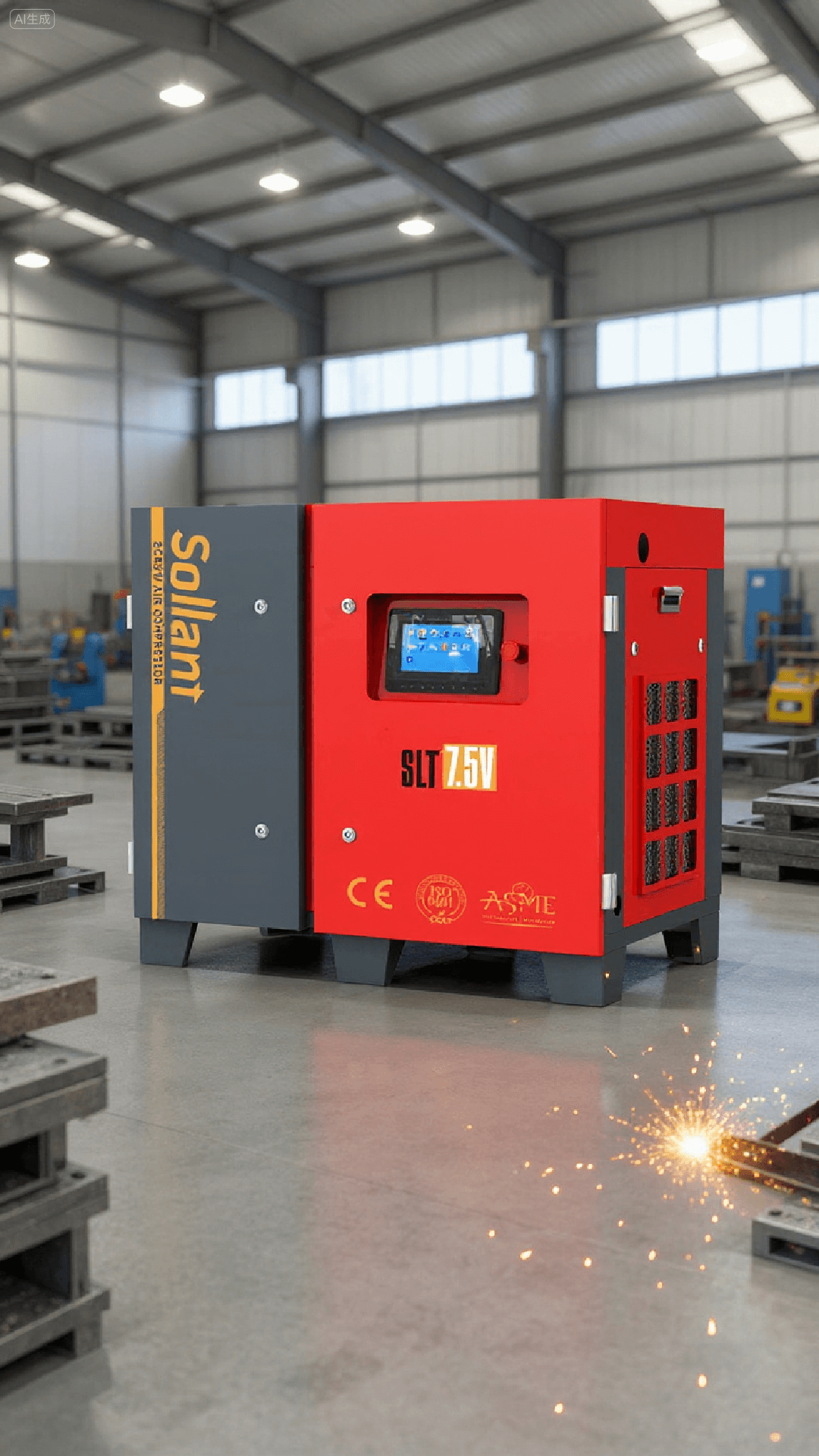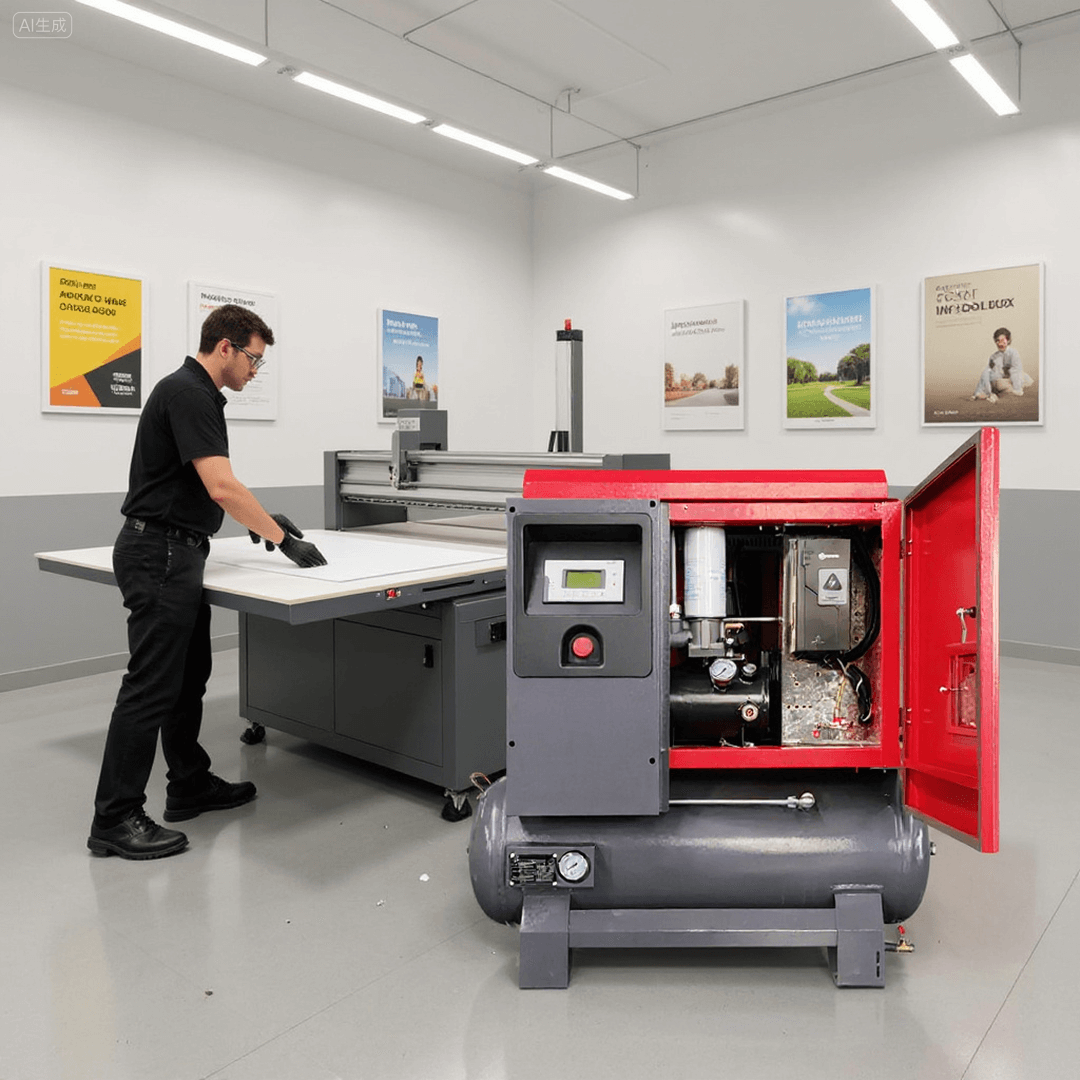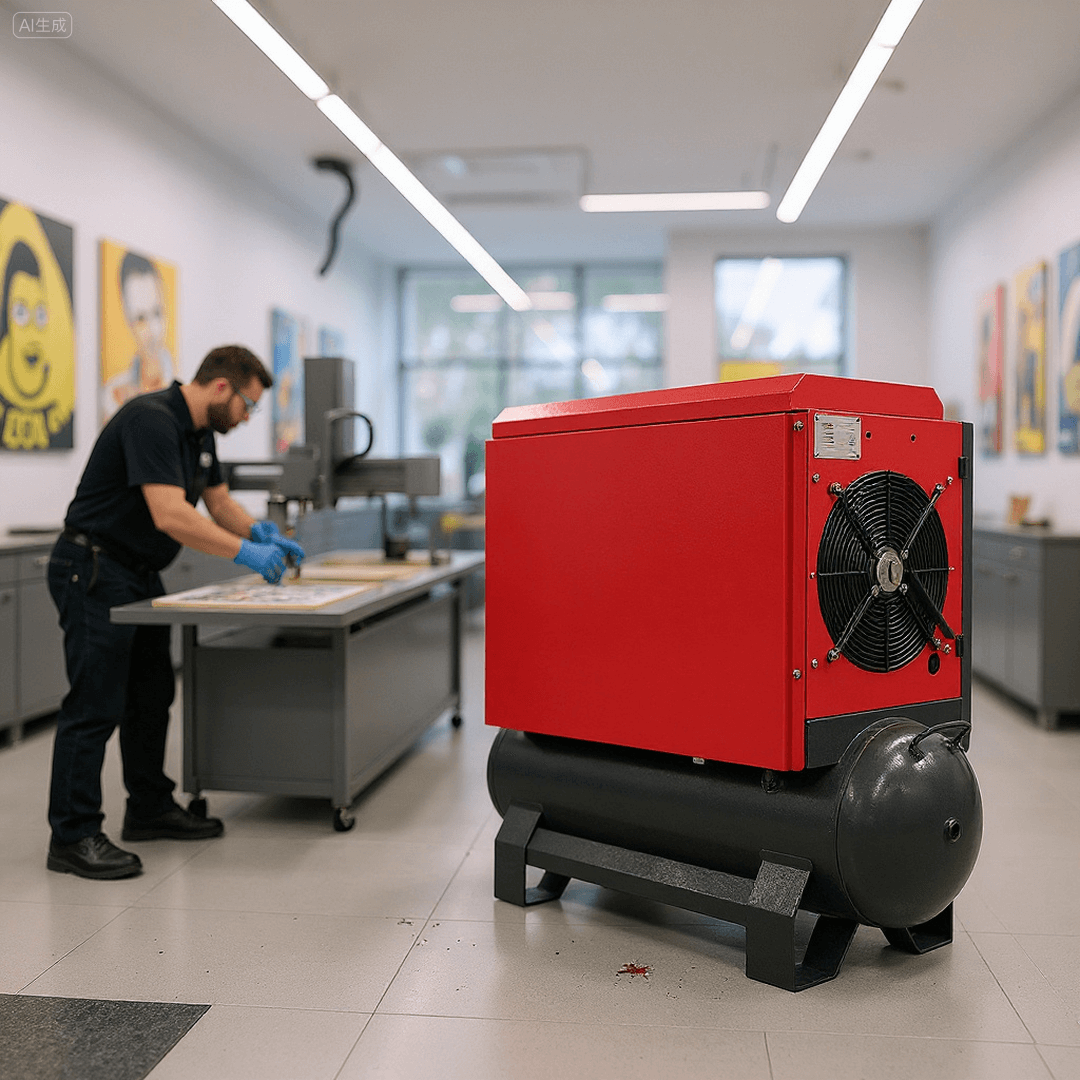What to Inspect During Screw Air Compressor Operation

When you use a Screw Air Compressor, you should check some things. This helps keep the machine safe and working well. Many people forget to do regular checks. But these easy steps stop problems like getting too hot or broken bearings.
-
About 60% of factories use air compressors for important jobs.
-
Most problems happen because people do not do maintenance, there are electrical problems, or parts wear out.
Sollant says you should watch the machine in real time and take care of it before problems start, no matter what brand you use.
Table of Contents
Key Takeaways
-
Check your screw air compressor every day to find problems early. This means you should look at oil levels, check for leaks, and listen for strange noises.
-
Change filters and oil often, depending on how much you use the machine. Clean filters help keep pressure steady and save energy. New oil helps the machine run smoothly.
-
Safety is very important, so check safety devices often. Act fast if you see warning signs like overheating or weird sounds. Acting quickly can stop expensive repairs.

Daily Checks
Doing daily checks helps your Screw Air Compressor work well. These checks help you find problems before they get worse. If you check your compressor every day, you can stop big repairs and save time. Sollant says these steps help your machine last longer and use less energy.
Oil Level and Lubrication
Check the oil level every day. Look at the sight glass on your Screw Air Compressor. The oil should be between “MAX” and “ADD” or about two-thirds full. If the oil is too low, parts will not get enough lubrication. This can cause damage quickly.
If you do not have enough lubrication, big problems can happen. You might get oxidation, dirty oil, or even a broken compressor. These problems mean more time fixing things and higher costs.
If the oil looks dirty or keeps going down, add more or change it. Sollant uses good parts to help keep oil clean and steady. This helps your compressor work well.
Air and Oil Leaks
Leaks waste energy and can hurt your compressor. Look for oil stains near seals, pipes, and the oil tank when the compressor is on. Use soapy water or leak fluid on spots you think might leak. If you see bubbles, you found a leak. You can also listen for hissing or use a UV light to find leaks in oil with special dye.
|
Method |
Description |
|---|---|
|
Visual Inspection |
Look for oil stains near seals, pipes, and the oil tank when the compressor is on. |
|
Leak Detection Fluid |
Put leak fluid on spots you think might leak; bubbles mean a leak. |
|
Ultraviolet (UV) Detection |
Use a UV light to see special dye in oil, which shows small leaks. |
|
Sound Detection |
Listen for leak sounds with a stethoscope or your ear. |
|
Oil Level Monitoring |
Watch if the oil level drops, even if you do not see leaks. |
|
Temp & Pressure Monitoring |
Check if oil temperature or pressure changes, which can mean a leak. |
If you find a leak, fix it fast. Sollant compressors are made to stop leaks. This saves energy and keeps your system safe.
Noise and Vibration
Listen to your compressor when it is running. Strange sounds or shaking can mean something is wrong. Here are some sounds to notice:
-
Metallic clashing: Metal parts hitting, maybe from loose parts.
-
Rhythmic knocking: Tapping sounds, often from worn bearings or rotor problems.
-
Squealing: High screeching, usually from belt trouble.
-
Whistling: High noise, often from valves or pipes.
Bad vibration can mean worn bearings, unbalanced shafts, or broken rotors. If you hear or feel something strange, stop the compressor and check it. Watching for noise and vibration helps you find problems early. Sollant makes compressors that run quietly and smoothly, so you can notice changes.
Condensate Drain
Water collects inside your compressor, especially when it is humid. You need to drain water from the receiver tank, dryers, and pipes. If you forget, rust and corrosion can hurt your system.
-
Drain receiver tanks by hand every week.
-
If it is very humid, drain every day.
-
Check automatic drains every week to make sure they work.
Sollant compressors have good drain systems to help keep water out and protect your machine.

Safety Devices
Safety devices keep you and your compressor safe. Check them every day to make sure they work. Here are the main ones:
|
Safety Device |
Function |
|---|---|
|
Safety Valve |
Lets out air if pressure gets too high, stopping tank damage. |
|
Pressure Relief Valve |
Releases air if pressure goes above safe levels. |
|
Relief Valves |
Stop overpressure by letting air out of tanks. |
Test the safety valves and look at the pressure gauges. If something is wrong, fix it before using the compressor again. Sollant cares about safety, so you can trust their compressors.
Tip: Write down the pressure, temperature, current, and voltage every 1-2 hours. This helps you see changes and keep your Screw Air Compressor working well.
Daily checks help you find leaks, worn parts, and other problems early. If you do these checks, your compressor will last longer and your work will go smoothly. Sollant’s design and good parts make daily checks easy and helpful.
Weekly and Monthly Checks
You want your Screw Air Compressor to run smoothly all year. Weekly and monthly checks help you catch problems before they get big. These checks go deeper than daily ones. Here’s a quick look at how they compare:
|
Frequency |
Focus Areas |
Tasks Involved |
|---|---|---|
|
Daily |
Operation and safety |
Visual checks, oil, draining water, monitoring gauges |
|
Weekly |
System health |
Clean/replace filters, check belts, inspect cooling system |
|
Monthly |
Detailed maintenance |
Lubricate parts, change oil, clean drains, inspect hoses |
Filter Condition
Check your air filters every week. Dirty or clogged filters make your compressor work harder and waste energy. Look for dust, dirt, or signs of wear. Replace filters if they look dirty or after three to six months, depending on your environment. Sollant uses advanced filter materials that last longer and keep your air clean. You can also ask Sollant for custom filter solutions if your site has special needs.
-
Inspect filters monthly for dirt or clogs.
-
Change or clean filters during weekly checks.

Belt and Coupling
Belts and couplings transfer power inside your compressor. If they wear out, you might hear grinding, whining, or buzzing. Check for cuts, cracks, or misalignment. Feel for vibrations or listen for odd noises. If you spot damage, fix it right away to avoid bigger problems. Sollant designs their compressors for easy belt checks and smooth operation.
Hoses and Connections
Look at all hoses and connections every month. Check for leaks, cracks, or loose fittings. Use soapy water to spot leaks. Tighten or replace anything that looks worn. Keeping hoses in good shape stops air loss and keeps your system safe.
Cooling System
Your cooling system keeps the compressor from overheating. Clean the radiator and cooler every week. Dust or oil buildup can block airflow and raise temperatures. Make sure fans work and nothing blocks the vents. Sollant compressors have easy-to-clean coolers to help you keep things running cool.
Air Dryer
Air dryers remove water from compressed air. Check your air dryer every week. Clean the filters and coils. For refrigerated dryers, look at the dew point and check for leaks. For desiccant dryers, monitor the dew point and inspect the desiccant. Replace filters and clean parts every few months. Sollant offers reliable air dryers that protect your equipment from moisture.
Tip: Regular weekly and monthly checks help you avoid costly repairs and keep your Screw Air Compressor running strong.
Screw Air Compressor Periodic Maintenance
Keeping up with periodic maintenance helps your Screw Air Compressor run smoothly and last longer. You can avoid big repairs and keep your air clean by following these steps.
Filter Replacement
You should replace filters on a regular schedule. Clean filters stop dust and dirt from getting into your system. When you change filters on time, you prevent pressure drops and save energy. Dirty filters can make your compressor work harder and use more electricity. They can also lower air quality and even damage your equipment. Sollant uses high-density filter materials that last longer and keep your air pure.
-
Change filters every 2,000 to 4,000 hours or at least once a year.
-
Clean filters help you meet strict air quality standards.
Oil Change
Oil keeps your Screw Air Compressor parts moving smoothly. You need to change the oil based on how much you use your machine. For most compressors, change mineral oil every 4,000 hours and synthetic oil every 8,000 hours. If you use your compressor a lot, check the oil more often. Always use high-quality oil and follow the factory’s advice. Sollant recommends keeping a service record so you never miss an oil change.
Valve Inspection
Valves control the flow of air and oil. Check them during each full maintenance. Look for signs of wear or leaks. If a valve sticks or leaks, replace it right away. This keeps your compressor safe and efficient.
Electrical System
Check the electrical system for problems like loose wires, tripped breakers, or blown fuses. Faulty wiring or bad connections can stop your compressor or even cause damage. Make sure all connections are tight and safe. Sollant offers support if you need help with electrical checks.
Separator Maintenance
The separator keeps oil out of your compressed air. A clean separator protects your equipment and keeps your air pure. It also helps your compressor use less energy. You should check and clean the separator during each full maintenance. Sollant’s durable separators help you avoid costly repairs and keep your system running strong.
Tip: Most experts suggest a full maintenance service every 2,000 to 4,000 hours or at least once a year. Regular care keeps your Screw Air Compressor working its best.
Immediate Shutdown Conditions
Sometimes, you must stop your screw air compressor fast. Acting quickly can save your machine and keep people safe. Here are warning signs you should always watch for.
Overheating or High Pressure
If your compressor gets too hot or pressure is too high, turn it off right away. High heat can hurt the motor and other parts. Always check the temperature and pressure gauges. Sollant compressors have easy-to-read displays, so you can see problems quickly. If the temperature goes up too much or the pressure is in the red, shut off the machine and let it cool.
Major Leaks
Big leaks are very dangerous. If you see oil or air spraying out, stop the compressor at once. Leaks waste energy and can cause accidents. Look around hoses, pipes, and seals for leaks. Sollant compressors help you find leaks fast, so you can keep your system safe.
Abnormal Sounds
Weird noises can mean something is wrong. If you hear any of these sounds, turn off the compressor and check for trouble:
|
Abnormal Sound |
Possible Issue |
|---|---|
|
Hissing |
Air leaks in the system |
|
Banging |
Loose or damaged internal parts |
|
Clicking |
Motor or bearing problems |
|
Internal mechanical issues |
|
|
Knocking |
Serious internal problems |
You might also hear squealing or whistling. These noises can mean belt or valve trouble. Never ignore new or loud sounds.
Safety Device Trigger
If a safety device goes off, stop the compressor right away. Safety valves, pressure relief valves, or alarms mean something is wrong. Sollant compressors have strong safety features to protect you and your machine. Always check what caused the shutdown before you start again.
Tip: If you are not sure, always pick safety first. Stopping the compressor quickly can stop bigger problems later.

Sollant Best Practices
Inspection Tips
You want your screw air compressor to last and work safely. Sollant recommends a few smart steps to help you get the best results:
-
Wrap electrical parts in plastic or oil paper to keep out moisture.
-
Drain water from the oil cooler and aftercooler completely.
-
Fix any problems before you shut down the machine.
-
Drain condensate again after a few days if the compressor sits unused.
-
Take off all protective covers before you start up again.
-
Check the motor’s insulation resistance.
-
Always follow the startup steps in your manual.
Tip: Make sure your air source stays steady. This helps your compressor run smoothly and saves energy.
Maintenance Intervals
Regular care keeps your compressor strong. Sollant suggests you:
-
Check and replace filters every 2,000 to 4,000 hours.
-
Change oil based on use—usually every 4,000 hours for mineral oil, 8,000 for synthetic.
-
Inspect belts, hoses, and safety devices every month.
-
Clean coolers and drain water weekly.
Here’s a quick table for easy reference:
|
Task |
Interval |
|---|---|
|
Filter Change |
2,000–4,000 hours |
|
Oil Change |
4,000–8,000 hours |
|
Belt/Hose Check |
Monthly |
|
Cooler Cleaning |
Weekly |
Support Services
Sollant stands by you with global support. You get:
-
Fast help from Sollant’s expert team.
-
Custom solutions for your needs.
-
Training for your staff.
-
Reliable spare parts and easy ordering.
Sollant believes in energy-saving and long-term reliability. You can trust Sollant to keep your air compressor running at its best, wherever you are in the world.
You keep your screw air compressor running strong when you stick to regular inspections and maintenance.
-
You spot problems early and avoid big repair bills.
-
Your compressor lasts longer and works better.
-
Sollant gives you reliable support and solutions for long-term equipment health.
Stay safe and save money with these simple steps!

FAQ
How often should you check your screw air compressor?
You should check your compressor every day. Sollant recommends daily inspections to catch problems early and keep your machine running smoothly.
What oil does Sollant suggest for screw air compressors?
Sollant suggests using high-quality synthetic oil. This oil helps your compressor last longer and keeps all parts moving smoothly.
Can you get help from Sollant if your compressor stops working?
Yes! Sollant offers fast support and expert advice. You can contact their team anytime for help with repairs or troubleshooting.


